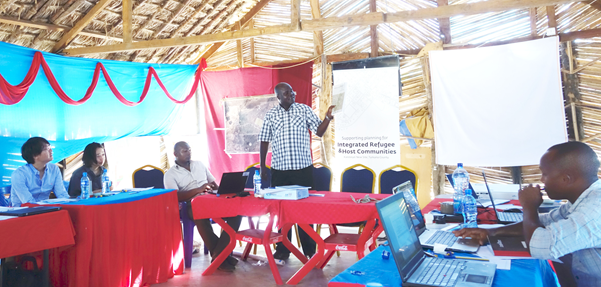The United Nations Human Settlements Programme (UN-Habitat) on Wednesday, May 31, 2017 invited ministers, Chief officers, directors and expert officers to discuss the content of the draft plan for Kalobeyei Refugee Resettlement in Kenya, including potential issues and development projects leading up to implementing the settlement development.

Mr. Mark Ewoi Ewesit, Chief Officer from The Ministry of Lands, Shelter and Urban Development, and Mr. Yo Ito, representative from the Government of Japan, opened the workshop, highlighting the collaborative efforts between the UN-Habitat, the County Government and refugee and host communities and the importance of urban strategies requesting specific regulations to allow for a comprehensive, integrated and sustainable settlement development.
In 2016, supported by the Government of Japan, UN-Habitat had joined in the implementation of Kalobeyei Integrated Socio-Economic Development Programme (KISEDP), the Turkana-based initiative chaired by UNHCR, which seeks to facilitate collaboration and coordination between the Kenyan Government, UN agencies, development actors, private sector and civil society to build sustainable services and economic opportunities in Kalobeyei Refugee Settlement.
Given the circumstances of continuous influx of refugees, Turkana County sought alternative approach to hosting refugees that can leverage the opportunities related to refugee settlements ability to stimulate sustainable growth. UN-Habitat in partnership with UNHCR, Turkana County Government and other partners prepared an integrated spatial plan for the Kalobeyei Settlement, aimed at demonstrating sustainable approaches to human settlement development.
The Spatial Plan, which has been formulated through a participatory process over a period of one year, is to be submitted to the County Government of Turkana, both as part of the collaboration process and also as part of the requisite plan approval process.
The Spatial Plan is setting the setting a spatial framework for coordinating programmes and projects for the other components/sub-components, towards the coordinated implementation under development and humanitarian interventions. The spatial plan has been developed based on a comprehensive socio-economic and mapping analysis conducted by UN-Habitat, as well as on a deeply participatory process involving refugee and host communities, local experts, international humanitarian and development organisations based on the ground and nevertheless continuous support and contribution from expert officers in different ministers in Turkana and the county legislature.
The workshop was structured in order to offer the ministries a clear presentation of the Spatial Plan guidelines and to ensure ownership of the County towards the Kalobeyei Settlement implementation. As Turkana natives are traditionally pastoralists, one of the main concerns was also the integration of locals into the new settlement, and to enhance their livelihoods in the growing economy. Further factors for consideration include greater emphasis on water provision, and provision of adequate technologies in terms of infrastructure and sanitation. The discussion approached also the relation between Kalobeyei Settlement and the Lodwar-Lokichogio Highway, which as part of a regional potential economic development scheme for future investment projects.
In terms of financial aspects, discussions on possible development directions were conducted with an emphasis on developing cost estimate that will be used as the entry point for promoting a financially and economic sustainable settlement. Potential partnership policies between the government and private sectors can also seek to enhance and capture development and construction costs, providing return of investments for both parties.
A session on the Kenyan legislative framework for community land and on the current land status of the settlement was also conducted. It focused on the current tenure of the settlement and on the possible scenarios to both protect the interests of the host community and ensure the long term sustainability of the settlement.
With acknowledgements to UN-Habitat expertise in urban planning and design, the Turkana County Government has expressed their confidence that once approved; the Spatial Plan can be implemented in lines with the County Development Plans, calling for UN-Habitat to support further social cohesion between refugee and host communities in Kalobeyei and neighboring settlements.
Honorary Members and staff of the Planning Committee of the County Assembly have previously conducted a validation of the draft Advisory Local Physical Development Plan for the Kalobeyei Refugee Settlement, promoting a positive overall feedback for the settlement development guidelines drafted by UN-Habitat. Experts from the UN-Habitat, key officers from the County Government are working towards achieving sustainable solutions for the settlement, and this workshop has set the basis for feasible implementation governed by the local authority.
